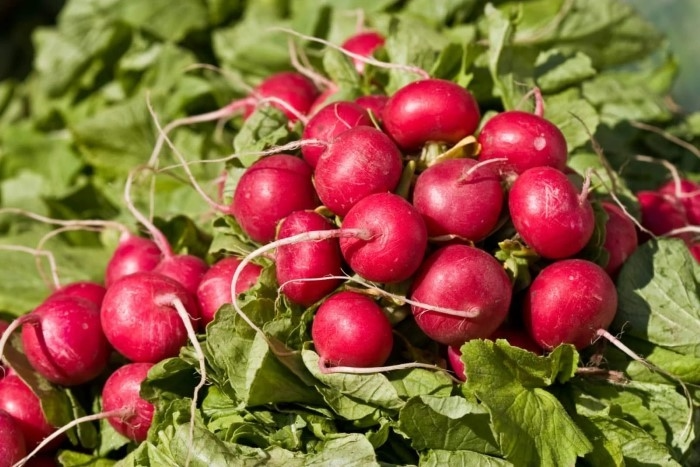Pink vegetables are a rare and visually striking group of plants that add a splash of color to meals while offering a variety of health benefits. Unlike traditional green vegetables, pink vegetables contain natural pigments called anthocyanins and betalains, which contribute to their unique hues and provide antioxidant properties.
These vegetables are not only beautiful but also packed with essential nutrients that support heart health, boost immunity, and promote overall well-being. Whether you’re looking to brighten up your plate or add more nutrient-dense foods to your diet, pink vegetables are a great choice.
List of Pink Vegetables and Their Benefits
Common Pink Vegetables
| Vegetable | Color Pigment | Key Nutrients | Health Benefits |
| Pink Radish | Anthocyanins | Vitamin C, fiber | Boosts immunity, aids digestion |
| Rhubarb | Anthocyanins | Calcium, potassium | Supports bone health, aids digestion |
| Pink Beetroot | Betalains | Iron, folate | Improves blood circulation, detoxifies liver |
| Pink Swiss Chard | Betalains | Magnesium, vitamins A & K | Supports heart health, reduces inflammation |
| Pink Carrots | Anthocyanins | Beta-carotene, fiber | Enhances vision, supports skin health |
Each of these pink vegetables not only provides vibrant color but also contributes to a healthier diet.
Why Are Some Vegetables Pink?
The pink coloration in vegetables comes from natural plant pigments, mainly anthocyanins and betalains. These compounds act as antioxidants, protecting cells from damage and reducing inflammation.
- Anthocyanins – Found in radishes, pink carrots, and Swiss chard, these pigments provide antioxidant and anti-inflammatory benefits.
- Betalains – Found in beets and rhubarb, these compounds support detoxification and improve blood circulation.
How to Cook and Use Pink Vegetables
Pink vegetables can be used in a variety of dishes, from salads to soups and stir-fries. Their unique colors make them a great addition to visually appealing meals.
Best Ways to Prepare Pink Vegetables
- Raw in salads – Radishes, pink carrots, and Swiss chard add crunch and color to fresh salads.
- Roasting – Pink beets and carrots caramelize beautifully when roasted, bringing out their natural sweetness.
- Blending in smoothies – Beets and pink carrots can be blended into nutrient-rich smoothies.
- Pickling – Radishes and beets take on a vibrant pink hue when pickled, adding a tangy crunch to meals.
- Soups and stews – Rhubarb and beets add depth and color to broths and stews.
Health Benefits of Pink Vegetables
Adding pink vegetables to your diet can provide a range of health benefits, from improved heart health to better digestion.
Key Health Benefits
- Rich in antioxidants – Protect cells from oxidative damage.
- Supports heart health – Lowers blood pressure and improves circulation.
- Boosts immunity – High levels of vitamin C strengthen the immune system.
- Aids digestion – Fiber-rich vegetables support gut health.
- Promotes skin health – Beta-carotene and vitamin A improve skin texture and appearance.
Where to Buy Pink Vegetables
Many pink vegetables can be found at local farmers’ markets, organic grocery stores, and online specialty produce suppliers. Seasonal availability may vary, so checking with local vendors is recommended.
Best Places to Find Pink Vegetables
- Farmers’ markets – Fresh, locally grown pink vegetables.
- Organic grocery stores – Specialty varieties like pink carrots and Swiss chard.
- Online produce suppliers – Rare vegetables delivered to your doorstep.
- Home gardening – Many pink vegetables can be grown in home gardens for fresh, organic produce.
FAQs
Are pink vegetables naturally colored?
Yes, pink vegetables get their color from natural pigments like anthocyanins and betalains, which also provide health benefits.
What is the healthiest pink vegetable?
Pink beets are one of the healthiest pink vegetables due to their high antioxidant and iron content, which supports blood circulation and detoxification.
Can pink vegetables lose their color when cooked?
Some pink vegetables, like radishes and rhubarb, may lose their vibrant color when cooked, while others, like beets, maintain their hue.
How can I grow pink vegetables at home?
Many pink vegetables, including radishes, beets, and Swiss chard, can be grown in home gardens with well-drained soil and regular watering.
Are pink vegetables good for weight loss?
Yes, most pink vegetables are low in calories and high in fiber, making them great for weight management and digestive health.
Pink vegetables are not only visually appealing but also packed with essential nutrients and health benefits. From pink radishes to beets and Swiss chard, these colorful vegetables can enhance meals while supporting overall wellness. Whether eaten raw, roasted, or blended into smoothies, pink vegetables are a delicious and nutritious addition to any diet.



